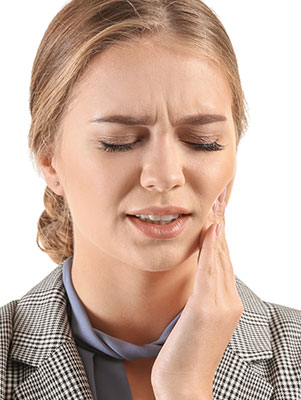Temporomandibular Disorder (TMD)
Millions of Americans suffer from chronic facial and neck pain as well as recurring headaches. In some cases, this pain is due to Temporomandibular Disorder, or TMD.
Your temporomandibular joints (TMJ) connect your lower jawbone to your skull. These joints get a lot of use throughout the day as you speak, chew, swallow, and yawn. Pain in and around these joints can be unpleasant and may even restrict movement.
Symptoms of TMD include:
- Pain in the jaw area
- Pain, ringing, or stuffiness in the ears
- Frequent headaches or neck aches
- Clicking or popping sound when the jaw moves
- Swelling on the sides of the face
- Muscle spasms in the jaw area
- A change in the alignment of top and bottom teeth
- Locked jaw or limited opening of the mouth
Should you notice any of these symptoms, let your doctor know. Your dentist can help indicate the presence of TMD and create an effective treatment just for you.
There are a few simple steps you can take at home or work to prevent TMD from becoming more severe, or to prevent it from occurring:
- Relax your face — remember the rule: "Lips together, teeth apart"
- Avoid grinding your teeth
- Avoid constant gum chewing
- Don't cradle the phone receiver between your head and shoulder — either use a headset or hold the receiver in your hand
- Chew food evenly on both sides of your mouth
- Do not sit with your chin rested on your hand
- Practice good posture — keep your head up, back straight, and shoulders squared
Facial Occlusal Stabilizing Appliance
A FOSA is a hard acrylic appliance that fits on your top teeth and is worn at night in the initial treatment phase. Your FOSA is fitted to allow your jaw joints to move to a comfortable seated position that may ease the symptoms that you are experiencing. A number of fittings might be needed as the chewing muscles, jaw joints and soft tissue continue to heal and reposition allowing the jaw joints to seat fully.
The FOSA must not be worn more than 10 hours a day until a diagnosis has been made and a treatment plan determined. The initial treatment phase, of nighttime wear only, is for a variable length of time depending on the resolution of your symptoms.
Many patients experience the symptoms (listed above) because of interference in their bite. The interferences may cause the jaw joints to be misaligned when the teeth fit together. If the jaw joints are out of position because of bite interferences then the chewing muscles can be strained and sore. During the day, your brain helps to ignore the interferences to allow your teeth to fit together.
When you sleep, your brain rests and can't help avoid the interferences that may exist in your bite. As the jaw joints try to return to a fully seated position, the interferences are encountered and this sometimes causes spasms in the chewing muscles. The muscle spasms could be further irritated by nighttime clenching or grinding. Almost all people have some type of interference in their bite that prevents the jaw joints from being in the most comfortable and fully seated position. Usually, people tolerate bite interferences. Life stress, trauma to the face, neck, or teeth, surgery to the jaw, wisdom teeth removal, orthodontics, or extensive dental work are all possible reasons the bite interferences could cause symptoms.
As healing takes place, your jaw joints will be able to seat into the desired position that is stable and reproducible, called Centric Relation.
Possible Outcomes of Night-time Wear of the FOSA
- The symptoms improve either partially or completely. You continue to wear the FOSA indefinitely.
- The symptoms resolve or improve and you would like a definitive treatment. That treatment could involve: occlusal adjustment, orthodontics, prosthodontics (crowns, implants, bridges) orthognathic surgery, or a combination of the above. In all cases, this phase would require a period of 24-hour wear of the FOSA to stabilize the jaw joints. Treatment plans are individualized.
- Despite daily FOSA wear, symptoms do not resolve. It is determined that the way your teeth fit together is not the source of your discomfort.
Caring for your FOSA
- Brush the FOSA before and after wearing, with toothpaste
- Store dry in the case provided at room temperature
- Keep away from animals, especially dogs
- Bring your FOSA appliance to every dental appointment


